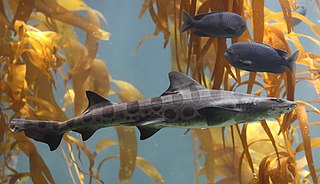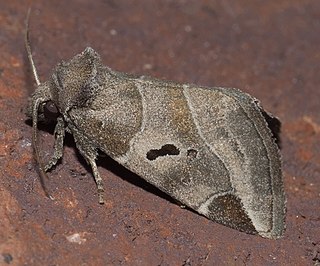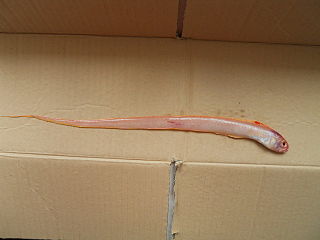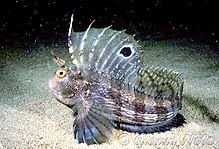
The Crassulaceae, also known as the stonecrop family or the orpine family, are a diverse family of dicotyledon flowering plants characterized by succulent leaves and a unique form of photosynthesis, known as Crassulacean acid metabolism (CAM). Flowers generally have five floral parts. Crassulaceae are usually herbaceous but there are some subshrubs, and relatively few treelike or aquatic plants. Crassulaceae are a medium-sized monophyletic family in the core eudicots, among the order Saxifragales, whose diversity has made infrafamilial classification very difficult. The family includes approximately 1,400 species and 34–35 genera, depending on the circumscription of the genus Sedum, and distributed over three subfamilies. Members of the Crassulaceae are found worldwide, but mostly in the Northern Hemisphere and southern Africa, typically in dry and/or cold areas where water may be scarce, although a few are aquatic.

Combtooth blennies are blenniiformids; percomorph marine fish of the family Blenniidae, part of the order Blenniiformes. They are the largest family of blennies with around 401 known species in 58 genera. Combtooth blennies are found in tropical and subtropical waters in the Atlantic, Pacific and Indian Oceans; some species are also found in brackish and even freshwater environments.

Pompanos are marine fish in the genus Trachinotus in the family Carangidae. Pompano may also refer to various other, similarly shaped members of the Carangidae, or the order Perciformes. Their appearance is of deep-bodied fishes, exhibiting strong lateral compression, with a rounded face and pronounced curve to the anterior portion of their dorsal profile. Their ventral profile is noticeably less curved by comparison, while their anterior profile is straight-edged, tapering sharply to a narrow caudal peduncle. Their dorsal and anal fins are typically sickle-shaped, with very long anterior rays and a succession of much shorter rays behind, with a similarly long & curved, deeply forked tail which has a narrow base. They are typically overall silvery in color, sometimes with dark or yellowish fins, and one or a few black markings on the side of their body. They are toothless and are relatively large fish, up to about 1.2 m (3.9 ft) long, although most species reach no more than half or two-thirds of that size. They are found worldwide in warmer seas, sometimes also entering brackish waters.

The Triakidae or houndsharks are a family of ground sharks, consisting of about 40 species in nine genera. In some classifications, the family is split into two subfamilies, with the genera Mustelus, Scylliogaleus and Triakis in the subfamily Triakinae, and the remainders in the subfamily Galeorhininae.

Tenthredinidae is the largest family of sawflies, with well over 7,500 species worldwide, divided into 430 genera. Larvae are herbivores and typically feed on the foliage of trees and shrubs, with occasional exceptions that are leaf miners, stem borers, or gall makers. The larvae of externally feeding species resemble small caterpillars. As with all hymenopterans, common sawflies undergo complete metamorphosis.

The cottonmouth jack is a gamefish in the family Carangidae. It was first described in 1860 by Cuban zoologist Felipe Poey in his two-volume work Historia Natural de la Isla de Cuba, or "Natural History of the Island of Cuba". It is also known as the cottonmouth trevally.

The vadigo, Campogramma glaycos, is a species of medium-sized coastal marine fish in the jack family, Carangidae. The species is distributed throughout the eastern Atlantic Ocean from the British Isles in the north to Senegal in the south, also entering the western Mediterranean Sea. The vadigo is similar in form to both the leatherjacks and the queenfish, but can be distinguished by its scaleless chest and a broad, rounded upper jaw. It is a predatory fish, preying mostly on smaller schooling fishes. The species was initially classified under the genus Centronotus before being transferred to its own monotypic genus of Campogramma. The vadigo is of minor commercial importance throughout its range, and is also considered to be a game fish.

The mackerel scad, or speedo, is a species of fish of the family, Carangidae. While it can be considered gamefish, it is usually used as bait. It is popular for consumption in Hawaiʻi, the Philippines and the U.A.E. In Hawaiʻi, mackerel scad are called ʻopelu. In the Philippines they are called galunggong.
Opistognathus is a genus of fish in the family Opistognathidae found in the Atlantic, Indian and Pacific Ocean.

Equinae is a subfamily of the family Equidae, known from the Hemingfordian stage of the Early Miocene onwards. They originated in North America, before dispersing to every continent except Australia and Antarctica. They are thought to be a monophyletic grouping. Members of the subfamily are referred to as equines; the only extant equines are the horses, asses, and zebras of the genus Equus, with two other genera Haringtonhippus and Hippidion becoming extinct at the beginning of the Holocene, around 11-12,000 years ago.

Byturidae, also known as fruitworms, are small family of cleroid beetles with over 15 described species, primarily distributed in the Holarctic and Southeast Asia. The larvae of at least some genera feed on fruit, such as Byturus, a notable commercial pest of Rubus consuming both the fruit and seeds, while others like Xerasia are associated with catkins. The adults are known to feed on developing leaves, flowers and pollen.

Tectariaceae is a family of leptosporangiate ferns in the order Polypodiales. In the Pteridophyte Phylogeny Group classification of 2016 (PPG I), the family is placed in the suborder Polypodiineae. Alternatively, it may be treated as the subfamily Tectarioideae of a very broadly defined family Polypodiaceae sensu lato. The family comprises seven genera, of which Tectaria is by far the largest.

Alticus is a genus of combtooth blennies found in the Pacific and Indian oceans. It is one of 57 genera in the family Blenniidae.

Stiriinae is a subfamily of owlet moths in the family Noctuidae. There are more than 20 genera and 130 described species in Stiriinae.

Ecsenius trilineatus, known commonly as the three-lined blenny in Australia, and the white-spotted comb-tooth or the white-spotted combtooth blenny in Indonesia, is a species of combtooth blenny in the genus Ecsenius. It is a non-migoratory species of blenny found in coral reefs in the western central Pacific ocean. It can reach a maximum length of 3 centimetres. Blennies in this species feed primarily off of plants, including benthic algae and weeds, and are commercial aquarium fish, but of no interest in fisheries.

Pseudocaranx is a genus of ray-finned fishes from the family Carangidae, the jacks, trevallies, scads, and pompanos. They occur in the western Atlantic Ocean and the Indo-Pacific.
Owstonia is a genus of marine ray-finned fish belonging to the family Cepolidae, the bandfishes. It is the only genus in the monotypic subfamily Owstoninae. They are found in deep waters of the Indian and Pacific Ocean.

The Apogoninae are the most species-rich and, of its shape, size, color and habitat, most diverse subfamily of cardinalfishes (Apogonidae). It can be found in coastal tropical and subtropical regions of the Indian Ocean, the eastern Pacific and the Atlantic, down to depths of 300 meters.

Salarinae is one of two subfamilies in the combtooth blenny family Blenniidae, it is the largest of the two subfamilies in the Blennidae with 43 genera. The species in this subfamily are mainly marine, with a few species which are found in freshwater or brackish water, and a few species are known to spend much time out of the water.

Cepolinae is one of two subfamilies of marine ray-finned fish belonging to family Cepolidae, the bandfishes.


















